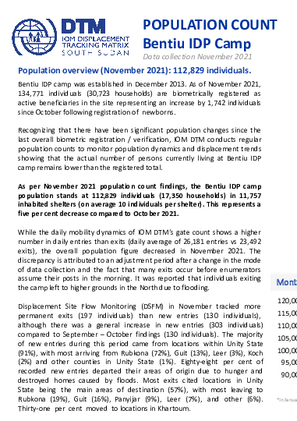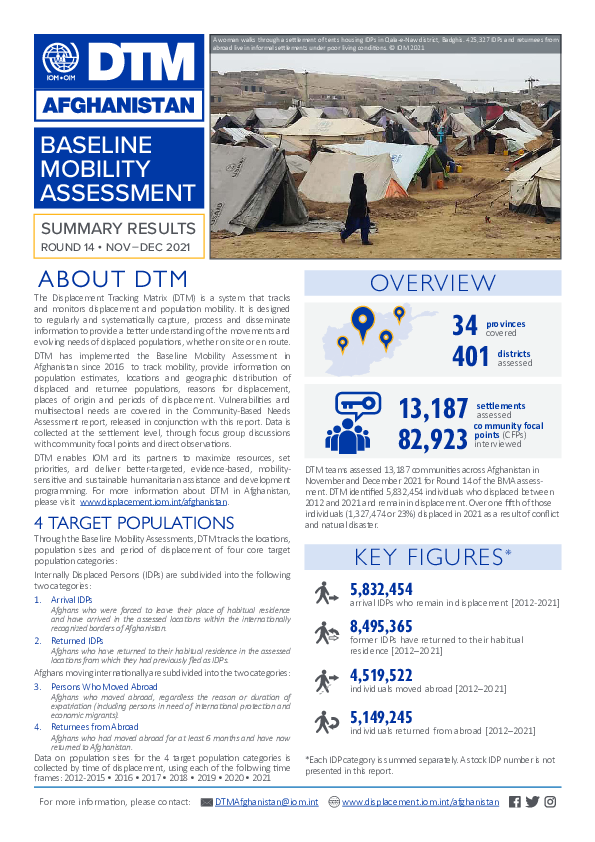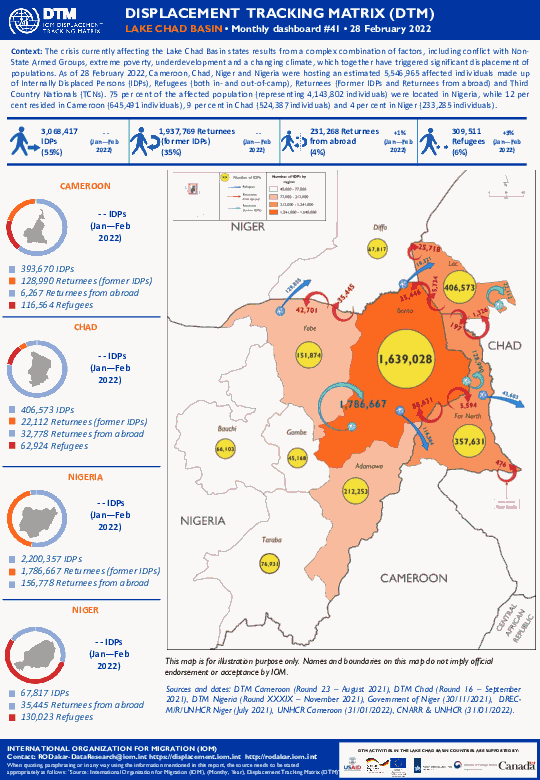-
Countries
-
Data and Analysis
-
Special Focus
-
Crisis Responses

Contact
DTM South Sudan, SouthSudanDTM@iom.int
Language
English
Location
South Sudan
Period Covered
Dec 01 2021
Dec 31 2021
Activity
- Site Assessment
- Registration
- Flow Monitoring
- Mobility Tracking
In December 2021, the monthly population count was conducted at Masna Collective Centre where 3,006 individuals / 684 households were identified and Naivasha IDP Camp where 7,765 individuals / 1,981 households were counted. The population of Naivasha IDP Camp decreased by 959 individuals as compared to November 2021.

Contact
DTM South Sudan, SouthSudanDTM@iom.int
Language
English
Location
South Sudan
Period Covered
Nov 01 2021
Nov 30 2021
Activity
- Site Assessment
- Registration
- Flow Monitoring
- Mobility Tracking
Bentiu IDP camp was established in December 2013. As of November 2021, 134,771 individuals (30,723 households) are biometrically registered as active beneficiaries in the site representing an increase by 1,742 individuals since October following registration of newborns. Recognizing that there have been significant population changes since the last overall biometric registration / verification, IOM DTM conducts regular population counts to monitor population dynamics and displacement trends showing that the actual number of persons currently living at Bentiu IDP camp remains lower than the registered total.

Contact
DTM South Sudan, SouthSudanDTM@iom.int
Language
English
Location
South Sudan
Period Covered
Jan 01 2022
Jan 31 2022
Activity
- Site Assessment
- Registration
- Flow Monitoring
- Mobility Tracking
Bentiu IDP camp was established in December 2013. As of January 2022, 134,946 individuals (30,841 households) are biometrically registered as active beneficiaries in the site, representing an increase by 175 individuals since November following verification of previously inactive beneficiaries. Recognizing that there have been significant population changes since the last overall biometric registration / verification, IOM DTM conducts regular population counts to monitor population dynamics and displacement trends. This exercise shows that the actual number of persons currently living at Bentiu IDP camp remains lower than the registered total.
Contact
DTMAfghanistan@iom.int
Location
Afghanistan
Activity
- Mobility Tracking
- Baseline Assessment
Period Covered
Nov 01 2021 -Dec 31 2021
A baseline assessment is a sub-component of mobility tracking. It aims to collect data on IDP, migrant or returnee population presence in a defined administrative area of the country.
This dataset contains information by settlement. Settlement is the lowest unit of observation used in Afghanistan
Population Groups
Survey Methodology
Unit of Analysis Or Observation
Type of Survey or Assessment
Keywords
Geographical Scope
Administrative boundaries with available data
The current dataset covers the following administrative boundaries
The crisis currently affecting the Lake Chad Basin states results from a complex combination of factors, including conflict with Non-State Armed Groups, extreme poverty, underdevelopment and a changing climate, which together have triggered significant displacement of populations. As of 28 February 2022, Cameroon, Chad, Niger and Nigeria were hosting an estimated 5,546,965 affected individuals made up of Internally Displaced Persons (IDPs), Refugees (both in- and out-of-camp), Returnees (Former IDPs and Returnees from abroad) and Third Country Nationals (TCNs). 75 per cent of the affected population (representing 4,143,802 individuals) were located in Nigeria, while 12 per cent resided in Cameroon (645,491 individuals), 9 per cent in Chad (524,387 individuals) and 4 per cent in Niger (233,285 individuals). The crisis currently affecting the Lake Chad Basin states results from a complex combination of factors, including conflict with Non-State Armed Groups, extreme poverty, underdevelopment and a changing climate, which together have triggered significant displacement of populations. As of 28 February 2022, Cameroon, Chad, Niger and Nigeria were hosting an estimated 5,546,965 affected individuals made up of Internally Displaced Persons (IDPs), Refugees (both in- and out-of-camp), Returnees (Former IDPs and Returnees from abroad) and Third Country Nationals (TCNs). 75 per cent of the affected population (representing 4,143,802 individuals) were located in Nigeria, while 12 per cent resided in Cameroon (645,491 individuals), 9 per cent in Chad (524,387 individuals) and 4 per cent in Niger (233,285 individuals).
Contact
DTMAfghanistan@iom.int
Location
Afghanistan
Activity
- Site Assessment
- Mobility Tracking
Period Covered
Nov 01 2021 -Dec 31 2021
A baseline assessment is a sub-component of mobility tracking. It aims to collect data on IDP, migrant or returnee population presence in a defined administrative area of the country.
This dataset presents a summary at the district level of data collected by DTM in Afghanistan.
Population Groups
Survey Methodology
Unit of Analysis Or Observation
Type of Survey or Assessment
Keywords
Geographical Scope
Administrative boundaries with available data
The current dataset covers the following administrative boundaries

Contact
DTMAfghanistan@iom.int
Language
English
Location
Afghanistan
Period Covered
Nov 01 2021
Dec 31 2021
Activity
- Mobility Tracking
- Site Assessment
In November through December 2021, DTM implemented the Community-Based Needs Assessment (CBNA) at the settlement level, as an integral component of DTM's Baseline Mobility Assessment (BMA), providing a comprehensive overview of the evolving, multi-sectoral needs in settlements hosting IDPs and returnees.

Contact
DTMAfghanistan@iom.int
Language
English
Location
Afghanistan
Period Covered
Nov 01 2021
Dec 31 2021
Activity
- Mobility Tracking
- Baseline Assessment
In Afghanistan, DTM employs the Baseline Mobility Assessment tool, designed to track mobility, determine the population sizes, locations and geographic distribution of forcibly displaced, return and migrant populations, reasons for displacement, places of origin, and times of displacement, as well as basic demographics, vulnerabilities and priority needs. Data is collected at the settlement level, through community focus group discussions with key informants and direct observations.
As of 31 December 2021, 34 provinces, 401 districts and 13,187 settlements have been assessed, including interviews with 82,923 community focal points. Between 2012 and December 2021, 5,149,245 returned migrants from abroad and 5,832,454 arrival IDPs currently living in host communities were identified.

Contact
DTM Nigeria, AllUsersInDTMNigeria@iom.int
Language
English
Location
Nigeria
Period Covered
Feb 14 2022
Feb 20 2022
Activity
- Event Tracking
- Mobility Tracking
Between 14 and 20 February 2022, a total of 2,131 movements were recorded in Adamawa and Borno States. The recorded movements consisted of 1,827 arrivals and 304 departures. Arrivals were recorded at locations in Askira/Uba, Bama, Gwoza and
Ngala Local Government Areas (LGAs) of the most conflict-affected State of Borno and in Fufore, Girei, Gombi, Hong, Lamurde, Maiha, Michika, Mubi North, Mubi South, Numan, Song, Yola North and Yola South LGAs of Adamawa State.
Departures were recorded in Askira/Uba and Bama LGAs of Borno, and in Fufore, Gombi, Hong, Maiha, Mubi South, Song and Yola North and Yola South LGAs of Adamawa State.

Contact
DTM Cameroun, DTMCameroon@iom.int
Language
French
Location
Cameroon
Period Covered
Nov 04 2021
Nov 12 2021
Activity
- Survey
- Return Intention
La Matrice de Suivi des Déplacements (Displacement Tracking Matrix – DTM, en anglais) est un outil mis en place par l’Organisation Internationale pour les Migrations (OIM), qui permet de faire le suivi des déplacements et la mobilité des populations. Elle collecte des informations à différents niveaux, les traite et les diffuse afin de garantir aux acteurs humanitaires, aux gouvernements et autres acteurs intéressés, une meilleure compréhension des mouvements et de l’évolution des besoins des populations déplacées : les facteurs d’influence, les moyens et durées de déplacement, les intentions futures des populations déplacées, leurs conditions de vie et encore bien d’autres éléments sont récoltés auprès de ces populations déplacées.
Ce rapport présente les résultats de la dernière enquête sur les intentions de retour menée auprès des ménages déplacés (Personnes Déplacées Internes (PDI) et réfugiés hors camp) en novembre 2021 dans 6 302 localités de la région de l’Extrême-Nord. Il permet ainsi de mieux comprendre le processus de décision des ménages déplacés, les raisons qui les poussent à partir ou les empêchent de revenir et les conditions nécessaires à un retour durable.
